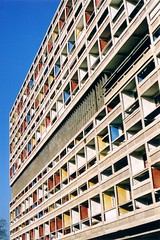Today the difference between a good and a poor architect is that the poor architect succumbs to every temptation and the good one resists it.--Wittgenstein, Culture and Value (the quotation is from 1930)
How can the difference between good and poor change so that it is something different "today" than it once was? Isn't it always the criterion of a good architect that he designs good buildings?
Well, what makes a building good? That depends: what is it for? In the light of this question, the architect (to put it roughly) chooses materials suitable to the purpose and within the means of the client to procure, and designs a form within the limitations imposed by this material. However, these last two limitations (the availability of materials and the physical constraints on the structuring of materials), as Le Corbusier observed in 1923, erode over time: "The technical equipment of this epoch -- the technique of finance and the technique of construction -- is ready to carry out this task [of conceiving and planning towns throughout their entire extent.]" The new range of possibility open to the architect, Le Corbusier says, requires a new "breadth of vision" to match it. Only by drawing form and material together under this "breadth of vision" would architects catch up to engineers, whose ready grasp of and application to "problems" had given them the edge. But Le Corbusier raises no question as to whether the first limitation on architecture, namely, what it is for, can in principle open up under the advances of technique, or whether the broadening of vision would always exceed the bounds of purpose within which a 'good building' is even conceivable.
One cannot be certain what Wittgenstein meant by "temptations" of architecture, but certainly enough a temptation was manifesting itself to the practice of architects for the first time as he wrote: a temptation to indulge the architect's vision on a scale indifferent to limitation. Here it is not a question of limitations imposed on a work by technical deficiencies, but of the confines (or in a more architectural term, the enclosure) of the form of life within which the work could take its direction.


No comments:
Post a Comment